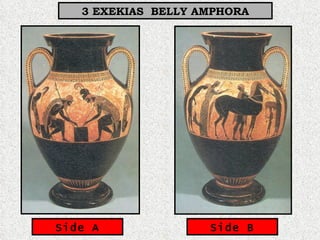
3. Exekias Belly Amphora
- 1. 3 EXEKIAS BELLY AMPHORA Side A Side B
- 2. Date: 550-40 BC Type: Belly Amphora-Black figure Potter: Exekias-signed Painter: Exekias-signed Height: 61 cm Subject: Side A: Achilles and Ajax playing a board game Side B: Return of Castor and Pollux to their parents Leda and Tyndareas. Q. What did the Greeks use amphorae for? A. The storage of wine, honey or oil.
- 3. *In this vase we will be concentrating on the details which the artist manages to convey through his art, and also looking at how the skills involved have developed and become more refined. Remember that Exekias is widely regarded as one of the best Black-figure artists of his time. You will need to memorise many of the impressive details about this vase for NCEA purposes. Exekias is widely regarded as the greatest craftsman / painter of Black-figure vases. Sensitive to pattern and design; uses many additional decorative motifs; adapts his composition to suit the shape of the vases. Makes innovative use of colour and uses small details to create naturalistic scenes.
- 4. Belly amphorae have an unbroken curve from the lip to the foot and were introduced at the beginning of the 6th century BC. This one is more elaborate than many because it has a stepped foot and flanged, rather than cylindrical handles. Exekias is usually regarded as the zenith, or high point of Black-figure painting. BELLY AMPHORA Exekias liked lively scenes, but also painted ones which captured the subdued parts of normally lively narratives . Subject matter
- 5. This depicts Ajax and Achilles. Ajax was the friend of Achilles who had found his armour and body after Achilles' death, but subsequently lost it to Odysseus. They are playing a board game of some sort. Achilles calls "four" Ajax calls "three". Note that Ajax's speech comes out backwards. Side A
- 6. This depicts the arrival home of the diskouri. From left to right the figures are: Pollux (named here as Polydeuces), a dog, Leda (mother of the twins), Castor (standing behind the horse), a slave (carrying a table with some clothes on it), and Tyndareus (step-father of the twins). The story of the birth, or rather conception of the twins is interesting as it involves Zeus visiting Leda in the guise of a swan and them having sex in this fashion. Side B
- 7. One tableau, or scene bordered above by lotus and palmette chain with separated leaves, bordered below by a red band. Ivy leaves on the handles. The base area of the body of the vase is encircled by ray bans. The internal composition of the main frieze is known as an inverted composition because of the way the figures and spears are arranged. Note that the focal point of the piece is the board and the game, the players are totally oblivious to the Trojan War going on around them: this has been echoed by the composition that the Painter has chosen. It also allows for an easy balance of the material within the frieze. Composition Remember, this is the way in which the various scenes of the vase are put together.
- 8. The backs of the two characters form an ‘A’ which highlights the upper contours of the shape of the vase. Conversely to this the spears also form an ‘A’, here the lower contours of the curve of the belly are highlighted. This shows us that the vase was well planned and carefully executed in its artistry by the painter. We can see impressive details of incisions in the following areas: i) Mane of the horse ii) Armour iii) Ornamentation iv) Clothes of Achilles and Ajax v) Muscle contours of Castor vi) Beards and Hair vii) Dress of Leda viii) Sinews of the horse Stylistic Detail